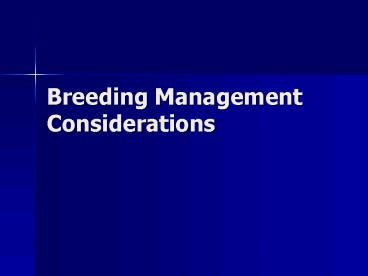Breeding Management Considerations - PowerPoint PPT Presentation
1 / 27
Title:
Breeding Management Considerations
Description:
Mare will recycle with PGF if not in foal. 13% of mares lose pregnancy between 15 and 40 days ... Increased mare and foal mortality. Premature placental ... – PowerPoint PPT presentation
Number of Views:52
Avg rating:3.0/5.0
Title: Breeding Management Considerations
1
Breeding Management Considerations
2
Whats the point
- Produce as many live healthy foals as possible
- Not highest conception rate
3
Farm managers ideal
- Breed only young (6 to 12 yrs) fertile mares
beginning early in the season - Rarely possible
- Young mares (lt6yrs) are harder to get in foal but
are less likely to lose the pregnancy - Mares over 12 years are slightly harder to get in
foal and much more likely to lose the pregnancy
4
- Lights
- Begin breeding early in season
- Good teasing program
- Teasing charts
- Try to breed each mare only once
- HCG, GnRH
5
When to breed relative to ovulation
- 24 48 hours before ovulation for natural
service - 12 24 hours before ovulation for AI with fresh
cooled semen - 6 -12 hours before ovulation for frozen semen
6
Stallion breeding frequency
- For natural service it may be up to 3 times per
day - For AI it is usually 3 to 4 times per week
7
Mare breeding frequency
- Depends on stallions book
- Every other day
- Once per cycle
- Twice per cycle
8
Post breeding exam
- Ultrasound to check for ovulation and fluid in
uterus
9
Pregnancy Exams 16-17 days
- Rebreed if not in foal
- Check for twins
- Check for fluid in uterus (infection)
10
Pregnancy Exam 40 days
- Mare will recycle with PGF if not in foal
- 13 of mares lose pregnancy between 15 and 40
days - 9 lose pregnancy between 40 days and term
- 45 day pregnancy certificate required by some
insurance and sales companies
11
Fescue
- Increased gestation length
- Agalactia
- Increased mare and foal mortality
- Premature placental separation
- Thickened placentas
- Weak dysmature foals
- Decreased fertility
12
Estrus and Ovulation timing
- Decreases time spent with each mare
- Coordinate breeding schedule with stallion
- Schedule breeding around competitive events
- Synchronize for embryo transfer
13
Selection of stallion
- Good Pedigree
- Good Record
- Good Conformation
14
General management
- Nutrition
- Exercise
- Housing
- Preventive medicine
- Artificial lighting
15
Stallion Nutrition
- Stallions tend to be overfed and fat
- Most stallions can do well on pasture or hay
- May need grain in Winter or under heavy work
- Balanced diet with free choice salt and water
- Healthy stallion consumes 2 3 of his body
weight per day
16
Stallion Nutrition
- Vitamin A deficiency can cause reduction in sperm
production - Green forages supply enough Vitamin A
- No evidence that any nutrient can increase sperm
numbers
17
Exercise
- Stallions need exercise
- Turn out
- Riding
- lunging
- Treadmill
- Swimming
- Mechanical walker
- Horse needs to maintain good attitude toward
exercise
18
Housing
- Stallions that live outside have higher levels of
testosterone and fertility than stallions that
are kept in barns.
19
Preventive medicine
- Parasite control
- Immunization
- Hoof care
- Dental care
20
Parasite control
- Deworming
- Most wormers considered safe
- Pasture management
- Pasture rotation
- harrowing
21
Immunization
- Specific programs vary
- Vaccinate at least 60 days prior to breeding
season - EVA
- Isolate stallion 28 days after vaccination
22
Coggins Test
- Annually
23
Hoof care
- Better to keep stallion barefooted and turned out
- Trim every 6-8 weeks
24
Dental care
- Examine once or twice yearly
- Perform work as needed
25
Artificial light program
- 16 hours daylight starting December 1 will have
mares cycling in February - It also stimulates stallion hormones fertility
- Stallions become refractory to light stimulation
and fertility decreases - Stallions may peak in fertility too soon in
breeding season
26
Stallion acclimation to breeding farm
- Stallion should arrive at farm 3 months before
breeding season - One person should handle the horse
- Be able to control the horse
- Teach stallion to stand and back
- Pull shoes
- Provide a small turn out paddock
- May need mild sedation first time
27
Stallion acclimation to breeding farm
- Introduce stallion to breeding shed and
procedures































